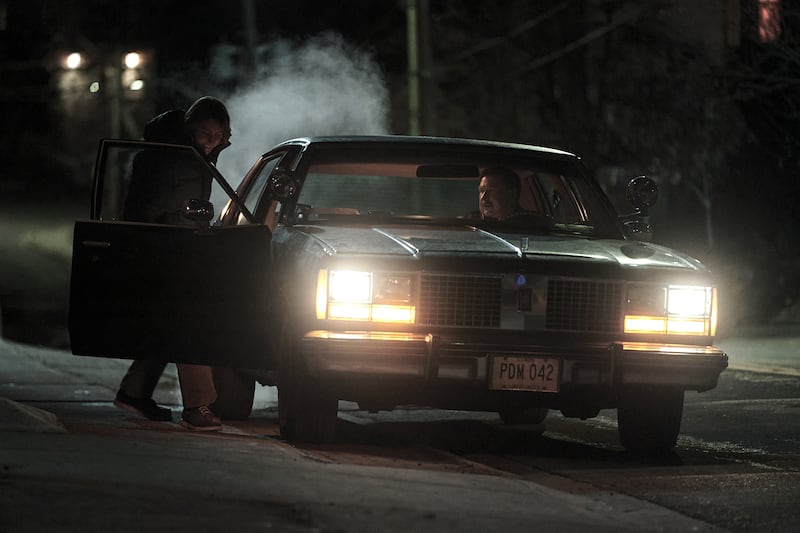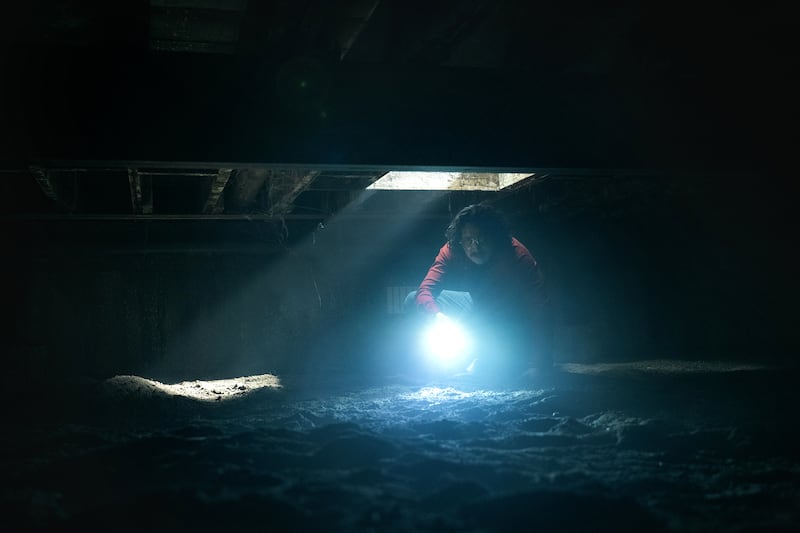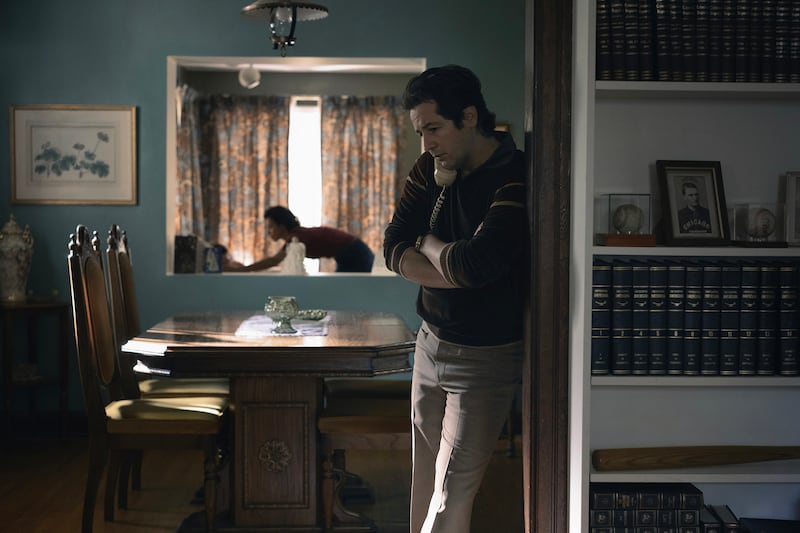The new eight-part Peacock series Devil in Disguise: John Wayne Gacy is anything but a clownish serial killer saga.
At the core of all true-crime stories is deep, inconsolable sadness, and the finest aspect of Devil in Disguise: John Wayne Gacy is that it recognizes and pays tribute to that fact.
Unfortunately, for all its sensitivity and sharp social critique, Patrick Macmanus’ eight-part Peacock miniseries (October 16) is short on actual drama, sacrificing suspense for sympathy. In a broad sense, it’s a noble attempt at reconfiguring the priorities of its chosen genre. Yet it’s also mildly unsatisfying, its efforts to avoid exploitation leaving it with little to do but commiserate with those picking up the pieces of its villain’s murderous spree.
Devil in Disguise: John Wayne Gacy is a far cry from Netflix’s recent Monster: The Ed Gein Story (and, for that matter, most likeminded affairs), fixated as it is on the aftermath of brutality rather than violence itself, as well as on the failures of a law enforcement system meant to serve and protect all.
Save for one brief shot from behind its subject, the series doesn’t even indulge in sights of Gacy (Severance’s Michael Chernus) in his Pogo the Clown makeup. Showing respect for the dead (and survivors, and family members), and censuring the police and prosecutors who repeatedly let Gacy off the hook—mistakes which could have saved dozens of lives—it’s as considerate as such ventures get. Even with regards to its fiend, it proves more interested in understanding his madness than deriving boogeyman scares from it.

Devil in Disguise: John Wayne Gacy eschews gory titillation, first and foremost, via its basic narrative construction. Macmanus’ show begins on Dec. 11, 1978 (“Day Zero”) with the disappearance in Des Plains, Illinois of Rob Pietz (Ryker Baloun) from a pharmacy where his mother Elizabeth (Marin Ireland) is waiting outside to drive him home for her birthday dinner.
Rob was supposedly going to talk to a man about a job at the time he bizarrely vanished, and Elizabeth and husband Harold (Greg Bryk) swiftly visit the police to explain that their son, a straight-and-narrow honors student who’s on the cusp of becoming an Eagle Scout, wouldn’t have willfully run away in this fashion.
Lieutenant Joe Kozenczak (James Badge Dale) listens to their pleas with a look of not-inconsiderable skepticism. Still, he gives the case to Detective Rafael Tovar (The Last of Us’ Gabriel Luna), whose sleuthing leads him to Gacy, who operates a contracting business which he staffs with young boys from the area, and who claims to have ties with police, politicians, and “the syndicate” (i.e., the mafia).
Gacy is a talkative fellow whose behavior is immediately fishy to Tovar, and Kozenczak has him tailed in the hope that he’ll crack under the pressure and give up Pietz’s whereabouts. This works like a charm, as Gacy hires neophyte lawyer Sam Amirante (Michael Angarano) and, before they can file a cease-and-desist motion against the cops, spills the beans about his offenses.

Subsequent searches of Gacy’s home, driven in part by a weird smell detected by one officer, turns up an unthinkable find: bodies, in various states of decomposition, buried in the residence’s crawlspace. As Tovar and his compatriots struggle to unearth the remains of dozens of individuals, brusque district attorney Bill Kunkle (Chris Sullivan) starts building his case, which qualifies for the death penalty, and Sam strives—with only moderate success—to get Gacy to cooperate on an insanity defense.
While depicting the discovery of Gacy’s heinousness and the ensuing work to bring him to justice, Devil in Disguise: John Wayne Gacy rewinds to detail the stories of some of his victims, all of whom are depicted as average, innocent kids—whether on the skids or simply looking for a job and enticed by Gacy’s friendliness and $5/hour wages—who, for one reason or another, entered the killer’s orbit.
Rarely featuring Gacy or any on-screen violence, these sequences are counterpoints to the ugly homophobia that tainted the kids’ portrayals at the time, both in the media and by the police. Macmanus’ takedown of law enforcement—both for its prejudice and its lack of inter-departmental communication—is harsh and persuasive, with his show contending that widespread disregard for gay men (and ugly ideas about their “rough” “horseplay” proclivities) was the number one reason Gacy was let out of jail early for pedophilic assault and then dismissed as a suspect for multiple crimes.

By humanizing the young men whom Gacy executed and focusing on the traumatic grief of their parents, Tovar and Kozenczak, and the lucky few who escaped the killer’s clutches—a mission underscored by episode-concluding non-fiction footage and photographs from the time—Devil in Disguise: John Wayne Gacy casts its tale as a tragedy rather than a twisted horrorshow.
Moreover, some expository writing notwithstanding, it offers a complex portrait of Gacy as a narcissistic schizophrenic sociopath with warped hang-ups about his father, his sexuality, and “greedy” hustlers, aided by a chillingly cheery performance by Chernus.
However, by concentrating on the anguish wrought by Gacy, the series doesn’t try to generate much tension; with the threat of Gacy’s capture eliminated by the plot’s inherent structure, the proceedings drag, weighed down by repetition and the absence of revelations or surprises.

Devil in Disguise: John Wayne Gacy’s intentions are admirable, but its execution increasingly falters, with numerous superfluous scenes—lowlighted by a late, cursory debate about capital punishment—padding its eight hours.
Despite the many things it does right, the series feels somewhat hollow, and that impression isn’t simply due to the fact that most of its flashbacks are left deliberately unfinished (to suggest the way in which these lives were cut abruptly short). By choosing to stay out of Gacy’s ghastly darkness, it sidesteps the black heart of its story, and that skirting-around-the-edges tack is pervasive, be it with the material’s address of Gacy’s marriages or Sam’s morally questionable decision to defend his client—a routine topic of conversation that never goes anywhere.
As a corrective to the bigotry of the era and much of the reporting that followed, not to mention the many true-crime predecessors who’ve gleefully wallowed in the Gacy muck, Devil in Disguise: John Wayne Gacy deserves praise. It’s too bad, though, that its goodwill doesn’t result in a more consistently captivating addition to the ever-burgeoning serial killer canon.
The post The New Series That Takes You Inside the Mind of John Wayne Gacy appeared first on The Daily Beast.




